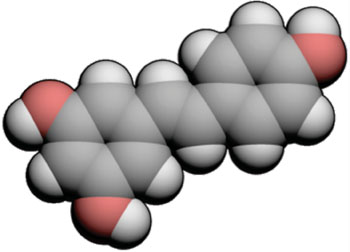Resveratrol Interacts with the Estrogen Receptor to Modulate Inflammation
By LabMedica International staff writers
Posted on 15 May 2014
A molecular mechanism has been identified that explains how the wine and grape product resveratrol modulates the inflammatory response by interacting with estrogen receptor-alpha.Posted on 15 May 2014
Resveratrol (trans-3,5,4'-trihydroxystilbene), a compound found largely in the skins of red grapes, is a component of Ko-jo-kon, a form of oriental medicine used to treat diseases of the blood vessels, heart, and liver. Red wine contains between 0.2 and 5.8 mg/L of resveratrol, depending on the grape variety, while white wine has much less—the reason being that red wine is fermented with the skins, allowing the wine to absorb the resveratrol, whereas white wine is fermented after the skin has been removed. Resveratrol came to scientific attention during the mid-1990s as a possible explanation for the "French Paradox"—the low incidence of heart disease among the French, who eat a relatively high-fat diet. Since then, it has been promoted by manufacturers and examined by scientific researchers as an antioxidant, an anticancer agent, and a phytoestrogen.

Image: Three-dimensional molecular space-fill model of resveratrol (Photo courtesy of Wikimedia Commons).
Investigators at The Scripps Research Institute (Jupiter, FL, USA) reported in the April 25, 2014, online edition of the journal eLife that resveratrol acted as a pathway-selective estrogen receptor-alpha (ERalpha) ligand to modulate the inflammatory response but not cell proliferation. A crystal structure of the ERalpha ligand-binding domain (LBD) as a complex with resveratrol revealed a unique perturbation of the coactivator-binding surface, consistent with an altered coregulator recruitment profile. Gene expression analyses revealed significant overlap of TNFalpha (tumor necrosis factor alpha) genes modulated by resveratrol and estradiol. In addition, the ability of resveratrol to suppress interleukin-6 transcription was shown to require ERalpha and several ERalpha coregulators
“Estrogen has beneficial effects on conditions like diabetes and obesity but may increase cancer risk,” said senior author Dr. Kendall Nettles, an associate professor at The Scripps Research Institute. “What has not been well understood until now is that you can achieve those same beneficial effects with something like resveratrol.”
“The problem with resveratrol,” said Dr. Nettles, “is that it really does not work very efficiently in the body. Now that we understand that we can do this through the estrogen receptor, there might compounds other than resveratrol out there that can do the same thing—only better.”
Related Links:
The Scripps Research Institute













